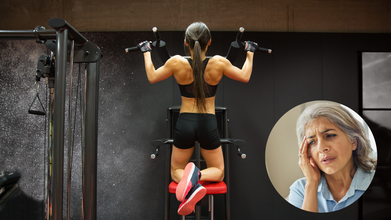- Health Conditions A-Z
- Health & Wellness
- Nutrition
- Fitness
- Health News
- Ayurveda
- Videos
- Medicine A-Z
- Parenting
- Web Stories
Shoulder Exercises For Men: 8-Week Workout Routine For Maximum Muscle Gain

Workout Routine For Maximum Muscle Gain (Credit: Canva)
As someone who's always been passionate about fitness, Naman realized that shoulder workouts were the missing piece in his routine. Over time, he learned that strengthening my deltoids and improving shoulder mobility was key not just for aesthetics, but for overall function. Now, he never skips a shoulder day!
Many men overlook the importance of shoulder workouts, often focusing on other muscle groups like arms or chest. However, neglecting shoulder exercises can severely limit your ability to achieve that coveted V-shape physique, no matter how many sit-ups or push-ups you do.
Strong, broad shoulders not only enhance your physical appearance but also improve overall posture and upper-body strength. Additionally, regular shoulder exercises can significantly reduce the risk of shoulder injuries and chronic pain, according to a study published in the International Journal of Sports Physical Therapy.
Before diving into shoulder exercises, it’s essential to understand the muscles involved. The shoulder is a highly dynamic joint, comprising two groups of muscles: extrinsic and intrinsic muscles.
The Extrinsic Shoulder Muscles
These muscles originate from the torso and attach to the bones of the shoulder, providing support and mobility:
Trapezius
This triangle-shaped muscle runs along your spine and shoulder blades, playing a key role in raising your arms and supporting your shoulders.
Latissimus Dorsi (Lats)
One of the largest muscles in the back, the lats are crucial for upper body strength and bodyweight management.
Levator Scapulae
Located at the back of the neck, this muscle is responsible for lifting the scapula (shoulder blade), which connects the upper arm bone (humerus) to the clavicle (collarbone).
Rhomboids
Positioned at the top of the back, these muscles pull your shoulder blades together, stabilizing your shoulder joints.
The Intrinsic Shoulder Muscles
These muscles originate from the scapula or clavicle and attach to the humerus, providing shoulder stability and rotation:
Deltoids
The deltoid is made up of three muscle fibers—anterior, lateral, and posterior—connected in a V-shape. This muscle is responsible for arm rotation and preventing shoulder dislocation during heavy lifting.
Teres Major
Sometimes called “lat’s little helper,” the teres major assists the latissimus dorsi in moving and rotating the arm.
Rotator Cuff
This group of muscles and tendons stabilizes the shoulder joint, ensuring the upper arm bone remains securely within the socket.
Is It Safe to Train Shoulders Every Day?
Training frequency depends on various factors such as age, recovery routine, diet, and workout intensity. While it’s tempting to focus on a single body part daily, especially when aiming for quick results, this can lead to overuse injuries and chronic pain. Overworking your shoulders without proper rest can strain the rotator cuff and other shoulder muscles, making you more susceptible to injury.
For most people, training the shoulders every 7 days is ideal. This allows for sufficient recovery time while still ensuring consistent progress.
How Long Does It Take to Build Stronger Shoulders?
Building shoulder muscles, like any other body part, requires patience, proper form, and consistent effort. Growth doesn’t come from endless repetitions but rather from smart training that allows for adequate recovery. The deltoid muscles, which are divided into anterior, lateral, and posterior sections, can be trained in isolation, allowing them to recover while you work on other muscle groups.
8-Week Shoulder Workout Program
To achieve optimal results, we’ve designed a two-phase, eight-week shoulder workout program. This plan will focus on both muscle growth and endurance.
Phase 1: Weeks 1-4
In the first four weeks, you’ll concentrate on muscle development. The exercises are designed to push your limits while emphasizing proper form and progressive overload.
Exercises:
1. Arnold Dumbbell Press: Targets the front delts while also engaging the lateral and posterior delts.
2. Seated Lateral Raise: Focuses on the side delts. Doing this exercise seated reduces the chance of using momentum, ensuring the delts do most of the work.
3. Rear Lateral Raise: Strengthens the often-neglected rear delts. If you struggle to feel this muscle working, have a workout partner gently tap your rear delts during the exercise.
4. Face Pulls: Helps to develop the rear delts and maintain tension throughout the range of motion using a cable machine.
Sets and Reps:
- Arnold Dumbbell Press: 4 sets of 6-15 reps
- Seated Lateral Raise: 3 sets of 8-15 reps
- Rear Lateral Raise: 3 sets of 8-15 reps
- Face Pulls: 3 sets of 10-15 reps
Rest Periods:
- Week 1: 90 seconds
- Week 2: 80 seconds
- Week 3: 70 seconds
- Week 4: 60 seconds
Phase 2: Weeks 5-8
In the second phase, the focus shifts to endurance and refining muscle definition. You’ll perform the same exercises as in Phase 1 but in giant set fashion, meaning you’ll complete all four exercises back-to-back without rest.
Sets and Reps:
- Arnold Dumbbell Press: 4 sets of 10 reps
- Seated Lateral Raise: 4 sets of 10 reps
- Rear Lateral Raise: 4 sets of 12 reps
- Face Pulls: 4 sets of 12 reps
Rest Periods:
- Week 5: 60 seconds
- Week 6: 55 seconds
- Week 7: 50 seconds
- Week 8: 45 seconds
Shoulder Workout Mistakes to Avoid
To maximize the effectiveness of your shoulder workouts, avoid these common mistakes:
Neglecting Shoulder Mobility
Ensure your shoulders are flexible enough before lifting overhead. If you can’t touch the floor with your arms overhead while lying flat, you may need to improve mobility before performing overhead presses.
Ignoring Eccentric Control
When lifting weights, controlling the movement both up and down is crucial for building muscle and avoiding injury. Don’t let gravity take over during the lowering phase of the lift.
Strong, well-developed shoulders not only improve your overall physique but also reduce your risk of injury. Adding the right shoulder exercises and paying attention to form, you can achieve broad shoulders that are as functional as they are impressive.
Stick to this 8-week program, stay consistent, and remember to give your muscles the time they need to recover. Your future self (and your posture) will thank you.
Long Walks Vs Several Short Walks? Study Reveals Which One Is Better For Your Health

(Credit-Canva)
Walking is said to be one of the best exercises. Not only is it an easy and accessible exercise, but it can be done anywhere and also does not need a lot of equipment. Many people aim for 10,000 steps a day as a sign of good health. But should you take one long walk, or multiple short ones? A new study has answered this question.
New research suggests that a single, longer walk each day is better for your heart than breaking up your steps into many short strolls, especially if you don't exercise regularly.
The study, published in Annals of Internal Medicine, found that walking for at least 15 minutes without stopping is ideal. This longer, steady pace, which is about 1,500 continuous steps gives your heart a much better workout.
Longer Vs Shorter Walks: Which is Better?
Researchers tracked the walking habits of over 33,500 adults in the UK who walked less than 8,000 steps a day. After tracking their health for eight years, the findings were clear:
Lower Heart Risk
People who consistently walked in longer, uninterrupted stretches had a lower risk of heart problems compared to those who only took short, quick bursts of steps.
Why Are Longer Walks Better For Health?
Even among the least active group (those walking under 5,000 steps daily), taking longer walks made a major difference. Their risk of heart disease and early death dropped significantly.
The researchers explain that most people focus only on the number of steps they take, but not the patterns. They suggests that even inactive people can boost heart health by changing their habits to walk for at least 10–15 minutes at a time.
Should People Focus More On How They Walk Or How Much?
Many people aim for 10,000 steps a day, but that number actually came from an old pedometer advertisement, not science. While experts agree more steps are generally good, this study emphasizes that how you walk matters more than just the total step count.
The researchers suggest that simple changes, like setting aside time specifically for a long walk, could make a big impact on heart health.
The NHS still recommends getting 150 minutes of moderate activity like brisk walking, each week, and ideally it should be spread out. For older adults, moving every day, even with light activity around the house, is key.
It's important to know that while the study shows a strong link between longer walks and better health, it doesn't definitively prove that walking directly causes the improvement.
However, health experts agree exercise is vital. They explain that you might find it hard at first, but it will get easier as your body adjusts. Even small improvements contribute to a healthy heart.
What Are Some Safety Tips for Walkers?
While walking is generally a safe activity, accidents can happen, especially if you like to walk alone. To stay safe while walking,
Be Visible
Wear bright, reflective clothing or carry a flashlight after dark or in dim light so drivers and others can easily spot you.
Stay Alert
Focus on your immediate surroundings; avoid distractions like your phone or headphones to always know what's happening around you, especially traffic.
Use Paths
Walk or bike only on marked paths, lanes, or sidewalks, and cross streets at designated crosswalks where vehicles are expecting pedestrians.
Donald Trump Health Update: First Hand Bruise, Now Swollen Ankle, Is The President Hiding A Health Crisis?

Credits: AFP/X
Donald Trump health has become a heated topic of debate and the concerns around his health has resurfaced after a photo from his Kuala Lumpur visit on Sunday, October 26, went viral. He was spotted with swollen ankles. The photo that went viral is from a meting of the Association of Southeast Asian Nations (ASEAN), which kicked off his six-day trip.
The pictures of his swollen ankle have flooded on social media and people are saying that his ankle is seen to be extremely swollen. As per experts, this happens due to chronic venous insufficiency, which is a condition Trump had earlier announced to be suffering from.

Chronic venous insufficiency occurs when the veins in the legs have trouble sending back to the heart. This causes blood to pool and creating high pressure. This is usually caused by damaged or weakened valves in the veins and is characterized by symptoms like leg swelling, aching, and heaviness, which improves with elevation. Risk factors include age, a history of deep vein thrombosis, and prolonged periods of sitting or standing.
However, Trump's latest physical test says something else. The White House physician Sean P Barbabella declared that the president "remains in exceptional health, exhibiting strong cardiovascular, pulmonary, neurological, and physical performance". Barbabella also stated that his "cardiac age was found to be approximately 14 years younger than his chronological age".
Trump's Legs Could Also Reveal That He Had A Stroke
As per a "Physical Therapist", who posts videos on Instagram by the username @epistemiccrisis with 74.2k followers, Trump also had his peroneal nerve paralyzed. He explains, "The deep branch of common peroneal nerve, which supplies a muscle known as the tibialis anterior, which blends your foot up toward your head when you walk. This is known as dorsiflexion. If this nerve is paralyzed, you would get a foot drop."
However, he notes that this can be easily remedied with a brace, called ankle foot orthosis or AFO. He said that the president was most likely wearing it as the outline of the posterior portion of "what looks like an AFO" could be seen through his pants.
Concerns On Trump's Health
Previously, the same "Physical Therapist" claimed that President Trump had a stroke. This is because he had difficulty walking in a straight line. In fact, a 2021 study published in journal Healthcare notes that stroke is a major cause of disability worldwide and balance impairments are common disabling factors in patients with stroke, which could lead to falls.
However, as per the official medical records of the president, no such strokes were mentioned. His medical report pronounced him in "excellent health". The examination was done at Walter Reed National Military Medical Center. The report also emphasized that Trump maintains a "demanding daily schedule without restriction". Not only that, the report has gone so far to declare Trump's cardiac age as 14 years younger than his actual age after an electrocardiogram.
This Simple Grip Test Could Predict Your Dementia Risk

Credits: Canva
Dr Peter Attia, physician, and researcher known for his work in longevity medicine believes that there is a correlation between your grip strength and dementia onset risk and dementia mortality.
Dr Attia says, "My best explanation for this is that grip strength is itself a proxy for overall strength. The type of strength we are talking about here is acquired, not inherited. You had to do a bunch of work to get it, and it is the work you did that is actually what's protect your brain."
He says that women who are over 40, must be able to hand on a bar for a minute and a half, and for men, it is two minutes. The key is that you are supposed to be able to carry 75% of your weight, he says, in an interview with CBS News' 60 minutes.
Is There Any Truth In The Claim That Grip Strength Has A Correlation With Dementia?
As per a 2021 study published in journal Frontiers in Aging Neuroscience, titled Grip Strength and the Risk of Cognitive Decline and Dementia: A Systematic Review and Meta-Analysis of Longitudinal Cohort Studies, loss of grip strength and cognitive impairment are prevalent in the elderly, and they may share the pathogenesis in common.
The study found that poorer grip strength was in fact associated with more risk of cognitive decline and dementia. The subgroup analysis within the study also indicated that people with poorer strength had more risk of Alzheimer's disease and non-AD dementia.
But why does this happen? Lower grip strength is a marker for overall muscle mass, general health, and is linked to the health of the brain and its blood vessels. This link is also connected to other factors like vascular health, cognitive decline, and physical activity, as low grip strength can be a symptom of poor overall physical and metabolic health.
How Is Lower Grip Strength Is Linked To Dementia?
Indicator Of Overall Health: Grip strength reflects the health of entire body, this is why a lower grip strength is an indicate of lower muscle mass, and general poor health.
Vascular and brain health: Since there is a connection between muscle strength, blood flow, and brain health, thus lower grip strength is associated with a higher risk of vascular dementia and a greater volume of white matter hyperintensities in the brain.
Also Read: What Home Gym Tools Can Help You Stay Fit Without Hitting The Gym?
Poorer grip strength is associated with lower cognitive function, such as fluid intelligence and prospective memory. This suggest a link between the body's physical capabilities and the brain's cognitive abilities.
A different study published in 2022, where 40,000 participants from the UK Biobank were studied found that greater grip strength was associated with better cognitive functioning, higher life satisfaction, greater subjective well-being, and reduced depression and anxiety symptoms while controlling for numerous demographic, anthropometric, and socioeconomic cofounders.
The study also found that grey matter volume of subcortical region also correlated with better mental health and considerably mediated their relationship with grip strength.
© 2024 Bennett, Coleman & Company Limited

